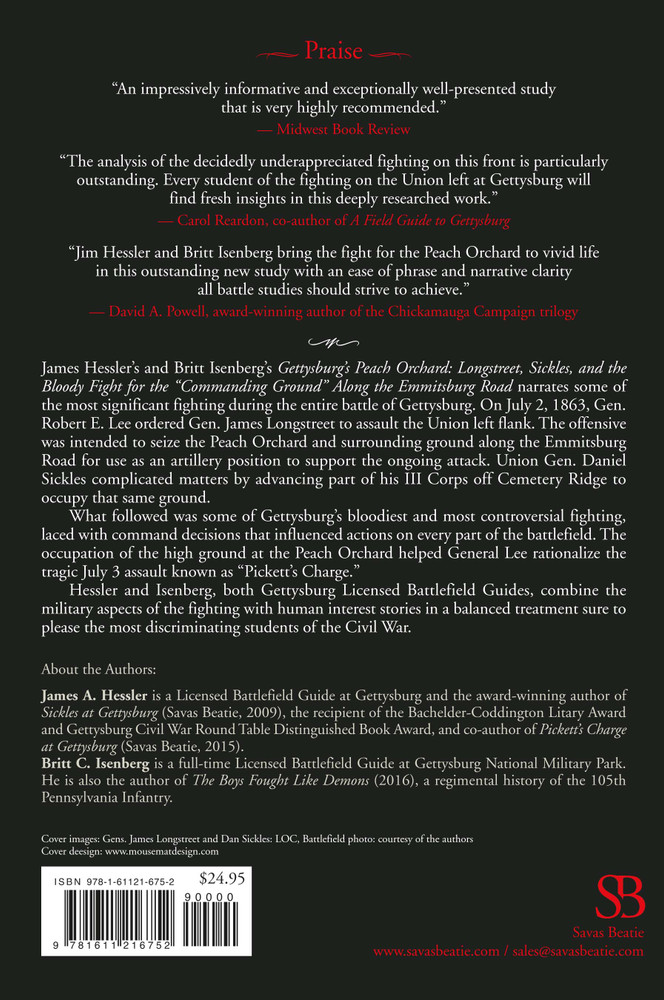Gettysburg’s Peach Orchard: Longstreet, Sickles, and the Bloody Fight for the “Commanding Ground” Along the Emmitsburg Road (PB)
- Current Stock:
- Gift wrapping:
- Options available
- Author/Editor:
- Hessler/Isenberg
- Pub Date:
- March 2023
- ISBN:
- 978-1-61121-675-2
- eISBN:
- 978-1-61121-456-7
- Binding:
- Trade paper, 6 x 9
- Specs:
- 54 images, 26 maps, 416 pp.
- Signed bookplates:
- Available.
Winner, 2019, The Bachelder-Coddington Literary Award,
Given by the Robert E. Lee Civil War Round Table of Central New Jersey
EXCERPTS
2. Chapter 3: "Incomprehensible Movements"
About the Book
On July 2, 1863, Confederate Gen. Robert E. Lee ordered skeptical subordinate Lt. Gen. James Longstreet to launch a massive assault against the Union left flank. The offensive was intended to seize the Peach Orchard and surrounding ground along the Emmitsburg Road for use as an artillery position to support the ongoing attack. However, Union Maj. Gen. Daniel Sickles, a scheming former congressman from New York, misinterpreted his orders and occupied the orchard first.
What followed was some of Gettysburg’s bloodiest and most controversial fighting. General Sickles’s questionable advance forced Longstreet’s artillery and infantry to fight for every inch of ground to Cemetery Ridge. The Confederate attack crushed the Peach Orchard salient and other parts of the Union line, threatening the left flank of Maj. Gen. George Meade’s army. The command decisions made in and around the Sherfy property influenced actions on every part of the battlefield. The occupation of the high ground at the Peach Orchard helped General Lee rationalize ordering the tragic July 3 assault known as “Pickett’s Charge.”
This richly detailed study is based upon scores of primary accounts and a deep understanding of the terrain. Hessler and Isenberg, both Gettysburg Licensed Battlefield Guides, combine the military aspects of the fighting with human interest stories in a balanced treatment of the bloody attack and defense of Gettysburg’s Peach Orchard.
Reviews
“Enhanced with the inclusion of an informative introduction (A Fatal Mistake), photographs, illustrations, and Appendix (Select Order of Battle), a twenty-four page Bibliography, and an eleven page Index, Gettysburg's Peach Orchard: Longstreet, Sickles, and the Bloody Fight for the "Commanding Ground" Along the Emmitsburg Road is an impressively informative and exceptionally well presented study that is very highly recommended as a core addition to personal, community, and academic library American Civil War military history collections and supplemental curriculum studies lists.” – Midwest Book Review
“In this finely detailed study of the clash in and around Joseph Sherfy’s Peach Orchard on July 2 at Gettysburg, James Hessler and Britt Isenberg restore the voices of Union andConfederate soldiers of all ranks who demonstrated a depth of courage and commitmentfar too often overshadowed in the historical narrative by controversies centering onGenerals Sickles and Longstreet. Their analysis of the decidedly underappreciated fighting on this front is particularly outstanding. Every student of the fighting on the Union left at Gettysburg will find fresh insights in this deeply researched work.” - Carol Reardon, co-author of A Field Guide to Gettysburg
“The Civil War has many blood-soaked acres; once-peaceful pastures, fields, and orchards were suddenly thrust into and immortalized by the maelstrom of war. On the afternoon of July 2, 1863, at Gettysburg, one such place suddenly became ‘The Peach Orchard,’ a scene of some of the most intense and confusing fighting of the entire war. The authors bring that encounter to vivid life in this outstanding new study with an ease of phrase and narrative clarity all battle studies should strive to achieve.” - David A. Powell, award-winning author of the Chickamauga Campaign trilogy and Union Command Failure in the Shenandoah
“Well-written and deeply researched, Gettysburg’s Peach Orchard by Licensed Battlefield Guides James Hessler and Britt Isenberg vividly recounts the brutal hellish combat in and around Joseph Sherfy’s peach trees and along the Emmitsburg Road on July 2, 1863. This study helps restore the critical importance of this terrain and its significance to the battle—long overshadowed by the fight on Little Round Top. Students of the battle will welcome this volume to their shelves.” - John D. Hoptak, historian and author of Confrontation at Gettysburg and The Battle of South Mountain
James A. Hessler is a Licensed Battlefield Guide at Gettysburg. He is the award-winning author of Sickles at Gettysburg (Savas Beatie, 2009), the recipient of the Bachelder Coddington Award and Gettysburg Civil War Round Table Distinguished Book Award, and co-author of Pickett’s Charge at Gettysburg (Savas Beatie, 2015). His media appearances include Travel Channel, NPR, PCN-TV, Breitbart News, Civil War Radio, and Gettysburg Daily. He was a primary content designer for the Civil War Trust’s mobile Gettysburg application and has written several articles for publication. He lives with his wife and family in Gettysburg. Britt C. Isenberg is a full-time Licensed Battlefield Guide at Gettysburg National Military Park since 2014. He has been published in several Civil War periodicals through writing and photography, and is the author of The Boys Fought Like Demons (2016), a regimental history of the 105th Pennsylvania Infantry. His tours at Gettysburg have also been featured on PCN-TV. Originally from Millersburg, PA, he resides with his wife and daughter near Gettysburg.









